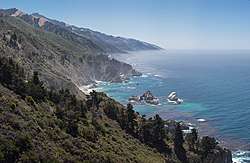Point Lobos
Point Lobos and the Point Lobos State Natural Reserve is the "crown jewel" of California's 280 state parks.[1] Australian-born landscape artist Francis McComas described the point as the "greatest meeting of land and water in the world."[2][3] Adjoining Point Lobos is "one of the richest marine habitats in California."[4] The ocean habitat is protected by two marine protected areas, the Point Lobos State Marine Reserve and Point Lobos State Marine Conservation Area. The sea near Point Lobos is considered one the best locations for scuba diving on the Monterey Peninsula and along the California coast.[4]
| Point Lobos State Natural Reserve | |
|---|---|
IUCN category V (protected landscape/seascape) | |
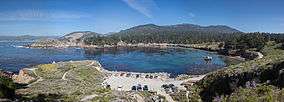 Looking north over Whaler's Cove, the largest of a number of coves in Point Lobos, and the location of Whalers Cabin. | |
  | |
| Location | Monterey County, California, United States |
| Nearest city | Carmel-by-the-Sea |
| Coordinates | 36°31′1.56″N 121°56′33.36″W |
| Governing body | California Department of Parks and Recreation |
| Designated | 1967 |
Point Lobos is just south of Carmel-by-the-Sea, California, United States, and at the north end of the Big Sur coast of the Pacific Ocean. Point Lobos features a number of hiking trails, many alongside the ocean, and a smaller number of beaches. The historic Whalers Cabin, built by Chinese fishermen and later used by Japanese and Portuguese fishermen, is now a museum.
Point Lobos nearly became the site of a town. In 1896, the Carmelo Land and Coal Company subdivided the land into 1,000 lots and named the new town "Carmelito". Engineer Alexander Allan purchased the land and over many years bought back the lots that had been sold and erased the subdivision from the county records. As of 2017, more than one million annual visitors from around the world visited Point Lobos, which is restricted by only 150 on-site parking spaces. The majority of visitors must park on the shoulder of Highway 1 and walk into the reserve.[5][6] Visitor levels are exceeding the capacity of the Reserve and the state is considering requiring reservations during peak hours.
Geography and natural features


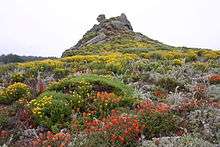
The Point Lobos area is geologically unique and contains a rich and diverse plant and animal life both on shore and in the water. Called the "greatest meeting of land and water in the world" by Australian-born artist landscape artist Francis McComas,[7][2][3] Point Lobos is considered the "crown jewel" of the California state park system. The geological history of Point Lobos describes the rocks that create the headlands and inlets that make Point Lobos famous.
The Carmel submarine canyon lies just north of Point Lobos. Like Monterey Canyon to the north the canyon provides cold, nutrient-rich water to the surface during upwelling events. These nutrient-rich waters fuel the high primary productivity seen in Carmel and Monterey Bays, which in turn support the high diversity of life observed in the water and on land at Point Lobos.
Point Lobos is one of only two places where the Monterey Cypress are native.[8] The waters around Point Lobos contain extensive kelp forests.
It is possible for visitors to watch whales off shore during certain portions of the year as they migrate along the coast. Gray,[9] humpback, and blue whales are regular visitors to the area.
Recreation and visitor impact
The reserve has several miles of trails. Visitors can view the coastal scenery, explore the coast, and picnic. California's marine protected areas encourage recreational and educational uses of the ocean. The quality of the underwater environment in the adjacent marine protected areas draws a large number of scuba divers. Whaler's Cover is often used by divers to begin their dives.[10] Other activities include kayaking, snorkeling, and diving. The large number of visitors is causing erosion in some places. The Point Lobos Foundation has coordinated volunteer days with the goal of planting hundreds of native species to restore eroded areas.[5] Point Lobos State Natural Reserve is planning to reduce overcrowding by requiring visitors to obtain reservations at peak times.[11]
Marine Protected Areas
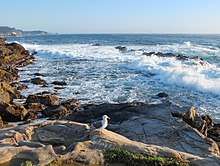
%2C_Point_Lobos%2C_CA%2C_US_-_Diliff.jpg)
_colony%2C_Point_Lobos_-_Diliff.jpg)
%2C_Point_Lobos%2C_CA%2C_US_-_May_2013.jpg)
The original Point Lobos Ecological Reserve was created in 1973. It has become "one of the richest marine habitats in California." Divers may not take any fish or mollusks within the reserve.[4] The Point Lobos marine protected areas provide shelter to a wide range of fish, invertebrates, birds, and marine mammals, from those that rely on the near-shore kelp forest to those that inhabit the deep waters of the Carmel Submarine Canyon.[12]
In 2007, the California Department of Fish and Game expanded the ecological reserve and renamed it as the Point Lobos State Marine Reserve and Point Lobos State Marine Conservation Area. A no-take zone was extended from the east side of Monastery Beach to the mouth of MalPaso Creek.[13] They were two of 29 marine protected areas adopted during the first phase of the Marine Life Protection Act Initiative, a collaborative public process to create a statewide network of marine protected areas along the California coastline.
State Marine Reserve
Point Lobos SMR covers 5.36 square miles.[14] The SMR protects all marine life within its boundaries. Fishing and take of all living marine resources is prohibited.[15]
State Marine Conservation Area
Point Lobos SMCA covers 8.83 square miles.[14] Harvest of all living marine resources is prohibited in the conservation area except the recreational and commercial take of salmon, albacore, and the commercial take of spot prawn.[15]
Scientific monitoring
As specified by the Marine Life Protection Act, select marine protected areas along California's central coast are monitored by scientists to track their effectiveness and learn more about ocean health. Similar studies in marine protected areas located off of the Santa Barbara Channel Islands have already detected gradual improvements in fish size and number.[16]
Whaling Station Museum
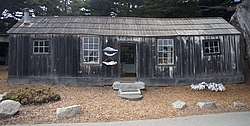
The historic Whalers Cabin at Whaler's Cove was constructed in the 1850s to house Chinese and later Japanese fishermen. The Chinese used locally sourced pine and redwood for siding. The floor was originally dirt. The floor joists are supported by six whale vertebrae that rest on granite blocks quarried nearby. Originally, the floor was packed earth. There were originally about 10 cabins around the cove. The cabin may have been used by Portuguese whalers from the Azores, who harpooned whales off the coast and hauled their carcasses onshore at the cove. The Carmel Whaling Company operated from 1862 to 1879. From 1854 to the end of shore-based whaling in about 1900, there were only 16 shore whaling stations in California, with about 300 men involved. When kerosene oil was introduced in about 1880, whale oil became too expensive. Whaling was briefly reintroduced by the Japanese Whaling Company from 1898 to 1900.[17]
When the last resident moved out of the cabin in 1983, a park docent suggested turning the cabin into a museum. Improvements added after the Chinese era, like fiberboard walls and ceiling, wiring, and pipes were removed. Docents contacted descendants of the families who lived and worked at the cove to solicit contributions. California state parks exhibit specialists built displays around the artifacts.[17] It is the only building of this era that has been preserved. It houses the Whaling Station Museum dedicated to the cultural history of the point. The museum also highlights the history of Point Lobos, including its cinematic appearances and plans at the turn of the 20th century to develop the area for densely packed suburban housing.[18][19]
History
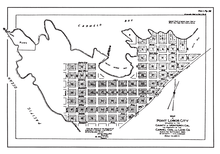
The Ohlone people harvested shellfish including abalone from the waters around Point Lobos. Evidence has been found of a long-term village named Ichxenta, in a meadow near San Jose Creek adjacent to Point Lobos, that indicates the natives inhabited the area for about 2,500 years. The village meadow is currently known as the Polo Field. There are 19 midden sites within Point Lobos and five sites containing mortar holes used by the natives for grinding acorns and seeds.[20][19]
It's likely that Sebastian Viscaino or some of his soldiers, who camped near the mouth of the Carmel River in 1602–03, may have visited the area to the south. Gaspar de Portolà and his exploring party camped at San Jose Creek in October 1769. Sergeant Jose Francisco Ortega conducted a study of the coast south of the Carmel River.[20][19]:37 In about 1770, Spanish Vaqueros from nearby Carmel Mission ran large herds of cattle in the area near Point Lobos.[21][22]
Ichxenta was likely occupied until near the end of the Carmel Mission era, when the native population was decimated by disease, starvation, overwork, torture, and forced assimilation.[23]:114
Spanish and Mexican era
Governor Juan Alvarado granted Rancho San Jose y Sur Chiquito, two square leagues of land, in 1839 to Marcelino Escobar, Alcalde (or mayor) of Monterey, Alta California. The grant was from the south side of Carmel River, including Point Lobos, 11 miles (18 km) south to Palo Colorado Canyon.[24][25]
Two of Escobar's sons, Juan and Agustin, obtained possession of the rancho shortly afterward, and sold it on August 26, 1841 to Doňa Maria Josefa de Abrego, who held power of attorney for her husband José Abrego to buy and sell land. She paid $250, one-half in silver, and one-half in gold, or about three cents per acre.[19][21]
Ownership of Point Lobos was later complicated by the fact that when Juan and Augustin Escobar sold the rancho to Josefa de Abrego in 1841, they didn't obtain permission from their multiple brothers and sisters. The siblings later contested the sale.[19]
Under somewhat mysterious circumstances, on January 16, 1843, Maria Abrego deeded the rancho to a group of about 10 soldiers from the Monterey Presidio. Records confirm the soldiers paid nothing, and a legend attached to the transfer says a gambler lost a rancho in a card game. Her husband was known for his gambling habit.[19] On June 7, 1844, the soldiers turned the Rancho over to their superior officer, Colonel José Castro, former Governor Alvarado's brother-in-law.[13]
After the Mexican–American War, Mexico ceded California to the United States. The 1848 Treaty of Guadalupe Hidalgo provided that the land grants would be honored. But the Land Act of 1851 required owners to prove their ownership. Castro filed a claim on February 2, 1853,[19] but grew impatient with the outcome and sold the land in 1854 to Joseph S. Emery and Abner Bassett for $700, leaving to them the legal fight for ownership.[13][26] The commission denied Castro's claim on August 28, 1855.[27] Castro died in 1860.[27] Emery and Bassett appealed the court's ruling. Bassett died in 1874, leaving his undivided one-half interest to his wife and eight children. Their half of the rancho was appraised at $15,000.[19]
In 1880, a lawsuit was filed in United States District Court to resolve the conflicting claims of more than two dozen putative property owners and squatters. On June 5, 1882, subject to confirmation of the original claim by Castro, the judges divided Escobar's original land grant into 34 parcels.[21] Later that year, Castro's original claim was validated by the court. The title was confirmed on December 24, 1885, and President Grover Cleveland signed the land patent on May 4, 1888, 35 years after Castro's initial filing.[28] All of the 34 claims from the 1880 lawsuit were invalidated as a result.
Industrial period
In 1851 a Chinese sailor, Quock Junk, ran aground at Point Lobos. He was rescued by members of the Ohlone tribe. He was later joined by four or five other Chinese families who built cottages at Whaler's Cove. They became the first commercial fishermen at the point. From 1854–1858, a granite quarry was operated at what was later named Whaler's Cove. The granite was used to build the Old Monterey Jail, San Francisco Mint, portions of Fort Point, and buildings on the Navy's installation at Mare Island Naval Shipyard. In 1862, Antonio Victorine, a Portuguese whaler from the Azores, arrived at Point Lobos, following the whale population. About fifty to seventy family members lived at Whaler's Cove. The men spotted whales from Whaler's Knoll and then rowed off shore about 1 mile (1.6 km) in 24-foot boats to harpoon the whales. They towed the whales back to Pt. Lobos to fleece and harvest the blubber. They then towed the carcasses back out to sea.[29][30]
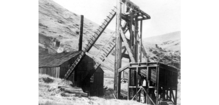
In 1874, a seam of low grade bituminous coal was found in upper Malpaso Canyon, southeast of Pt Lobos.[31] On September 6, 1888, shortly after the patent for Rancho San Jose y Sur Chiquito was approved, almost all of the owners banded together to form the Carmelo Land and Coal Company. In exchange for shares in the company, they sold their interest in the land for $1.[21] A mine was dug into the mountain near Malpaso Creek, and the coal was transported on ore carts via a tramway to Coal Chute Point, opposite the Chinese settlement at Whaler's Cove. The deep water allowed the workers to use the chute to deliver the coal directly to coastal steamers.[20][19]
In 1890, Emory and Bassett's heirs subdivided Point Lobos into 1,000 parcels. They begin selling lots for $25 to $50 to a new town they initially called Point Lobos City, but later renamed Carmelito.[20] The lack of a bridge across the Carmel River and two national economic recessions during the 1890s combined to severely restrict sales.[22][13] The outer portion of the point was reserved as the Point Lobos Park.[19]
In 1897, Alexander MacMillan Allan, a successful engineer from Pennsylvania, was hired to improve the coal mine operation. When he found the coal mine could not produce a profit, he purchased 640 acres (260 ha) of Point Lobos from the Carmelo Land and Coal Company in 1898. Marine biologist Gennosuke Kodani was already harvesting abalone from the area, a valuable delicacy in Japan. Allan partnered with him to build the Point Lobos Canning Company, which they operated until 1928.[32] Allan decided to move the remainder of his family from Oakland to Point Lobos.[33]

Allan added a sand and gravel mining operation to the Abalone cannery. In 1899 he had a narrow gauge railroad built from nearby San Jose Beach to Coal Chute Point to transport sand for shipment by sea to glass manufacturers in Alameda. Sand mining continued through 1954.[22][20] Allan established the Point Lobos Dairy at the mouth of San Jose Creek which was operated from 1903 until 1954.[13] He also became a successful race track architect and built the Santa Anita, Tanforan and Bay Meadows race tracks.[33][34] One member of the family sold a portion they inherited to form the Carmel Meadows subdivision.[33]
Tollgate installed
In 1899, Allan and his wife Satie, who grew to appreciate the natural beauty of the point, were concerned about the increasing number of visitors. People had been visiting the point for many years to see the rare Monterey Cypress trees and enjoy the scenic coastline. The Allan family put up toll gates, prohibited camping, and charged visitors 50 cents a vehicle (about $10 today) to enter the point. Allan bought many of the residential lots that had been subdivided and later got the entire subdivision removed from the county record.[35][21][22][13]
State interest in land
Scientists reported to the government that the Carmel area including Point Lobos was the "most picturesque spot on the Pacific Coast." In 1925, Point Lobos figured prominently in discussions for inclusion in the new state park system. Members of the Sierra Club and the Save the Redwoods League discussed preserving Point Lobos and Cypress Point as national parks or reserves.[19] Duncan McDuffie of the Save the Redwoods League hired the internationally known landscape architect Frederick Law Olmsted to research Point Lobos and report on the areas most noteworthy of preservation. Olmstead's report described Point Lobos as "the most outstanding example on the coast of California of picturesque rock and surf scenery in combination with unique vegetation, including typical Monterey cypress."[36] Point Lobos gained the attention of the newly established California State Park system, who considered taking the land using eminent domain. Allan initially resisted the idea of making the land a public park.[33][37] The family persuaded the state to wait until Allan died.[6]
Land sold
On February 8, 1933, three years after Allan's death, the Allan family sold 348 acres (141 ha) to the State of California for $631,000 (equivalent to $9,950,870 in 2018). The state promptly set about erasing evidence of human intrusion on the land, removing man-made structures like the abalone cannery, the railroad used to haul sand, and a number of homes and shacks, excepting a single Whalers Cabin.[6] The Allan family donated an additional 15 acres (6.1 ha) to the state of cypress-covered headlands at the western tip of the point as a memorial grove to Alexander and Satie Morgan Allan. The state added another 50 acres (20 ha) later on, expanding the reserve to almost 400 acres (160 ha).[38]
World War II use
At the beginning of World War II, a U.S. Army Coastal Defense Squad used the Whalers Cabin at Whaler's Cove for its headquarters. From 1942 to 1944, the cove was the site of a 4th Air Force Long-Range Radar site. Tents were set up to accommodate 90 men below Rat Hill. In July and August 1943, the U.S. Army established a training school for the 543rd Engineer Boat and Shore Regiment, 3rd Engineer Special Brigade, at Whaler's Cove at Point Lobos. The unit found that the cove was an ideal harbor for anchoring and maintaining their boats. The unit was later involved in 62 landings in the southwest Pacific.[39][40][41][13]
Modern changes
The Allan family retained the land to the east of Highway 1. Eunice Allan Riley, one of Alexander's three daughters, repurchased the last subdivided lots in the 1950s.[34][13][22] In 1960, 750 acres (300 ha) underwater acres were added as the first marine reserve in the United States. The marine reserve was designated an ecological reserve in 1973, and in 1992, was added to the Monterey Bay National Marine Sanctuary, the largest in the nation.[22][38]
In popular culture
A large number of movies have been made in or around Point Lobos.
- Valley of the Moon (1914)
- The Love Light (1921)
- Foolish Wives (1922)
- The Eleventh Hour (1923)
- Greed (1924)
- The Iron Mask (1929)
- Evangeline (1929)
- Daddy Long Legs (1931)
- Paddy, The Next Best Thing (1933)
- He was her Man (1934)
- Treasure Island (1934)
- Captain January (1936)
- Conquest (1937)
- Maid of Salem (1937)
- Rebecca (1939)
- Edge of Darkness (1943)
- Lassie Come Home (1943)
- Vertigo (1958)
- The Sandpiper (1965)
- The Graduate (1967)
- Turner and Hooch (1989).
See also
References
- "Point Lobos Foundation - Point Lobos Foundation". www.pointlobos.org. Retrieved 10 May 2018.
- Conaway, James. "Big Sur's California Dreamin'". Smithsonian. Retrieved 8 May 2019.
- Stienstra, Tom (30 March 2014). "Spectacular coastline at Point Lobos Reserve - SFChronicle.com". www.sfgate.com. Retrieved 8 May 2019.
- "Fantastic Diving | Point Lobos Foundation". pointlobos-org.cftvgy.org. Retrieved 8 May 2019.
- With almost one million visitors a year point lobos state park is dealing with the consequences of some of the footprints being left behind. KION. 19 Nov 2017. Retrieved 11 May 2018.
- Guara, Maria. "Point Lobos' natural beauty belies industrial past". SFGate. Retrieved 10 May 2018.
- "Marine Life | Point Lobos Foundation". www.pointlobos.org. Retrieved 8 May 2019.
- C.Michael Hogan and Michael P. Frankis. 2009. Monterey Cypress: Cupressus macrocarpa, GlobalTwitcher.com ed. N. Stromberg Archived 2017-09-06 at the Wayback Machine
- "WHALE swims by at Pt. Lobos on Jan 26! Photo by Clinton Bauder - Any Water Sports". 27 January 2013.
- Department of Fish and Game. California Fish and Game Code section 2853 (b)(3) Archived 2013-03-26 at the Wayback Machine Marine Life Protection Act. Retrieved December 18, 2008.
- Big Sur plea: Tourists, honor our home
- Department of Fish and Game. "Appendix O. Regional MPA Management Plans". Master Plan for Marine Protected Areas (approved February 2008). Retrieved December 18, 2008.
- The Whalers Cabin and The Whaling Station Museum (PDF), Point Lobos Foundation, 2017
- California Department of Fish and Game. California Marine Life Protection Act Initiative Summary of Central Coast MPAs as Adopted by the California Fish and Game Commission Retrieved on December 22, 2008.
- California Department of Fish and Game."Online Guide to California’s Central Coast Marine Protected Areas Retrieved on December 18, 2008.
- Castell, Jenn, et al. How do patterns of abundance and size structure differ between fished and unfished waters in the Channel Islands? Results from SCUBA surveys. Partnership for Interdisciplinary Studies of Coastal Oceans (PISCO) at University of California, Santa Barbara and University of California, Santa Cruz; Channel Islands National Park. Retrieved December 18, 2008.
- "Whalers Cabin". Point Lobos Foundation. Archived from the original on February 3, 2015. Retrieved 5 June 2018.
- Bertao, David. The Portuguese Shore Whalers of California, 1854-1904. San Jose, CA: Portuguese Heritage Publications, 2006. Page 106.
- Aubrey Drury, 1954, Point Lobos Reserve, California State Park, Department of Natural Resources, Sacramento, p. 78–85
- "The Allan Memorial Grove at Point Lobos State Reserve" (PDF). California State Parks. 2004. Retrieved 7 May 2018.
- Wiley, Marlene. "Point Lobos State Reserve". www.mnn.net. Retrieved 7 May 2018.
- "Point Lobos History". www.pt-lobos.com. Retrieved 7 May 2018.
- Pritzker, Barry M. (2000). A Native American Encyclopedia: History, Culture, and Peoples. Oxford [u.a.]: Oxford Univ. Press. ISBN 978-0-19-513877-1.
- "Diseño del Rancho San José y Sur Chiquito: Calif". Calisphere.
- "Rancho San Jose y Sur Chiquito". Geographic Names Information System. United States Geological Survey.
- Hoover, Mildred B.; Rensch, Hero; Rensch, Ethel; Abeloe, William N. (1966). Historic Spots in California. Stanford University Press. ISBN 978-0-8047-4482-9.
- Killea; Lucy Lytle (October 1966). "Journal of San Diego History". San Diego Historical Society. sandiegohistory.org. Archived from the original on April 11, 2005. Retrieved 16 June 2010.
- "Report of the Surveyor General 1844–1886" (PDF). Archived from the original (PDF) on 2009-05-04.
- Grimes, Teresa; Heumann, Leslie (January 7, 1997). "Historic Context Statement Carmel-by-the-Sea". ci.carmel.ca.us. Retrieved 30 December 2017.
- "Allan House". Alliance of Monterey Area Preservationists. Retrieved 10 May 2018.
- Walton, John (2003). Storied Land: Community and Memory in Monterey. Berkeley, Calif.: University of California Press. ISBN 978-0520227231. Retrieved 7 May 2018.
- Hirahara, Naomi (2001). Distinguished Asian American business leaders (1. ed.). Phoenix, Ariz.: Oryx. pp. 104–106. ISBN 9781573563444. Retrieved 7 May 2018.
- Rogers, Paul (2 December 2010). "Land deal near Point Lobos closes more than a century of preservation". The Mercury News. Retrieved 10 May 2018.
- "Obituary Margaret M. Allan". Retrieved 10 May 2018.
- "History of Point Lobos". pointlobos.org. Point Lobos Foundation. Archived from the original on August 31, 2014. Retrieved 7 May 2018.
- "Map of Point Lobos Proposed California State Park, a part of Rancho San José y Sur Chiquito in Monterey County, Cal. - Price Estimate: $150 - $250". www.pbagalleries.com. Retrieved 8 May 2018.
- Johnson, Jim (Oct 16, 2015). "Point Lobos Stone House demolition, development plans rankle neighbors". Monterey Herald. Retrieved 11 May 2018.
- "Point Lobos History - Point Lobos Foundation". www.pointlobos.org. Retrieved 10 May 2018.
- "Charles Wilson Spence's Obituary on The Augusta Chronicle". The Augusta Chronicle.
- "Co. C, 543rd Engineer Boat and Shore Regiment, 3rd Engineer Special Brigade". www.justinmuseum.com. Retrieved 11 May 2018.
- "3rd ESB Engineer Special Brigade, 533rd EB&SR, 543rd EB&SR, 593rd EB&SR". ebsr.net. Retrieved 11 May 2018.
External links
| Wikimedia Commons has media related to Point Lobos — Point Lobos State Reserve. |
- California State Park.gov: official Point Lobos State Natural Reserve website
- Point Lobos Foundation
- California's MPAs (marine protected areas)
- Virtual tour of the Central Coast MPA
